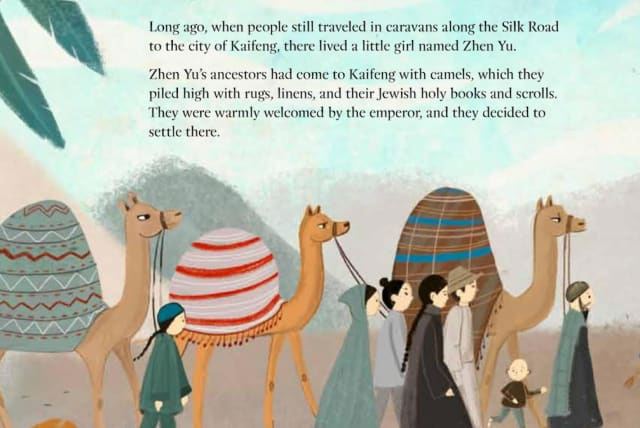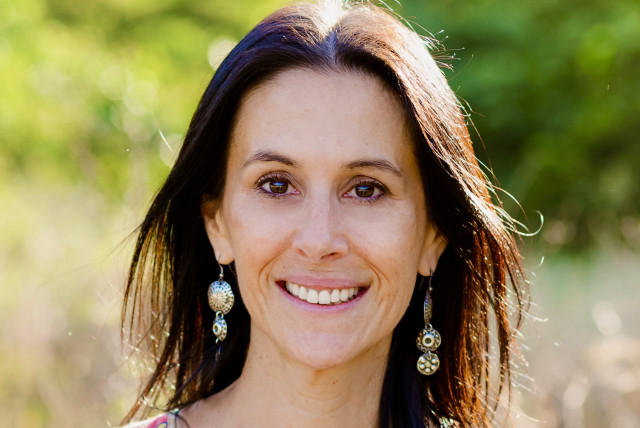A Talmudic tale gets a 12th-century Chinese twist in children’s book for diverse Jewish readers

Erica Lyons’ new children’s book, “Zhen Yu and the Snake,” is set in 12th-century Kaifeng, China, the city where Persian Jewish merchants established China’s first Jewish community.
Rabbi Akiva’s daughter was destined for death on her wedding day, at least according to the star-gazers. So the early Jewish sage seemed resigned to his daughter’s fate.
But on the wedding day, Rabbi Akiva’s daughter offered a poor old man her portion of the wedding feast. That night, before going to bed, she removed her hairpin and stuck it in the wall. In the morning, she discovered that the hairpin had pierced the eye of a poisonous snake, which trailed after the pin as she pulled it from the wall.
“Charity saves from death,” Rabbi Akiva declared.
Erica Lyons doesn’t remember the first time she heard this Talmud story, but she can’t forget its many strange omissions and inconsistencies. What rabbi listened to astrologers? Why wasn’t Rabbi Akiva worried about his daughter’s fate? And why didn’t Rabbi Akiva’s daughter have a name of her own?
“It sort of made me think of Jephtha’s daughter, this other girl who is going to potentially be sacrificed for the sake of a story, of a lesson of some sort,” said Lyons, referencing another biblical character from the Book of Judges.
Lyons’ new children’s book, “Zhen Yu and the Snake,” published last week with rich illustrations by Renia Metallinou, seeks to fill in those gaps — with a twist. The story is set in 12th-century Kaifeng, China, the city where Persian Jewish merchants established China’s first Jewish community. Its main characters are all Chinese Jews — Rabbi Akiva becomes Li Jian and his daughter finally gets a name, too: Zhen Yu, which means “precious jade” in Chinese. The astrologer in the story becomes a fortune-teller from the Chinese city of Chengdu, which was home to several famous fortune-tellers at the time.
At the time, Kaifeng was China’s vibrant Song Dynasty capital. Its location on the Yellow River, not far from the Silk Road, made it a commercial center bustling with merchants. The Silk Road trading route had attracted hundreds of Jews to China, who settled there around the 9th or 10th century and peacefully worshiped their own god for centuries.
In Lyons’ version of the story, Zhen Yu is the main character, who lives a life of virtue long before getting married. Common in Chinese culture, the presence of the fortune-teller feels natural in the Kaifeng market, where he reveals Zhen Yu’s fate to Li Jian on an afternoon before Shabbat.
Lyons stays loyal to the source text, highlighting the characters’ observance of Jewish law and the importance of Jewish values in their lives. But the setting and characters make the story more accessible to non-Ashkenazi readers, she said.
“The Talmud belongs to all Jews around the world,” said Tani Prell, creative director at Be’chol Lashon, a nonprofit dedicated to raising awareness about the racial, cultural, and ethnic diversity in Judaism, primarily through education. Encouraging teachers to include diverse Jewish stories is “a hard thing to do” when those resources are limited, Prell said. “So I think it’s beautiful that Erica is creating the resources that do have such a direct impact on the lived experiences of young Jews of color.”
Lyons, who has been living in Hong Kong for over two decades, had always wanted to be a writer. In college, she majored in English and Jewish Studies but began her career as a lawyer for an insurance company in New York. When she moved to Hong Kong with her husband in 2002, she saw the opportunity to get back to her undergrad roots.
Today, she is deeply involved with Hong Kong’s historic Jewish community, whose foundations were built by Baghdadi-Jewish dynasties such as the Sassoons and the Kadoories in the 19th and 20th centuries. The city’s Jewish population has fluctuated over the years but remains about 3,000-4,000 strong today with six congregations to choose from. Lyons chairs the Hong Kong Jewish Historical Society and serves as the Hong Kong delegate to the World Jewish Congress.
As a Persian-Ashkenazi Jew who is raising Chinese children, Lyons has prioritized the inclusion of Jews of diverse experiences in her work in Hong Kong. As a journalist and founder of Asian Jewish Life, a magazine that spotlighted Jewish stories in Asia from 2008 until 2016, she has always been fascinated by “Jewish stories in the margins” — little-known bits of Jewish history or traditions that have gone overlooked by the Jewish majority living in the West.
Today, few families in Kaifeng still observe Judaism, and those who do have been forced underground as part of the Chinese Communist Party’s policy of repressing and limiting a range of religions. Judaism is not one of the country’s five officially recognized religions (Protestantism, Catholicism, Buddhism, Daoism, and Islam), and Kaifeng’s Jews are seen by the state as part of the Han Chinese ethnic majority — not Jews. Little Jewish iconography remains on the old streets of Kaifeng today, and a majority of the country’s Jewish population are expatriates living in commercial centers such as Shanghai, Beijing, and Shenzhen.
Lyons’ book comes at a time when Jewish stories from Asia — especially stories of Jewish escape and survival in China and Japan during World War II — are receiving a wave of attention. In this year alone, stories about Jewish refugees in Asia have been the subject of multiple novels, an exhibition in New York City, a musical, and two high-profile symphony performances.
In these stories, China is often a temporary backdrop against which Western Jewish stories are set. There is less awareness of the history of the Chinese Jewish community in Kaifeng, Lyons said.
“In this way, I was able to educate people without being didactic in any way. I didn’t just pick a random city in China and plop my characters into it. I picked a Jewish community, and I think a lot of people are not aware that [Kaifeng] was a historic community,” she said.
Books for young readers about Chinese or Asian Jews, in particular, have been rare. But the widening availability of literature about diverse Jews in recent years is creating more demand for these stories, said Prell.
Nicholas Zane, an undergraduate student at Dartmouth whose family immigrated to the United States from China with the help of a Jewish family in the Catskills, has been developing accessible information about the Kaifeng Jews through a website, nonfiction books, and picture books in Chinese and English. “Two New Years,” a picture book published last month by Richard Ho, tells the story of a family that celebrates both Rosh Hashanah in the fall and Chinese New Year in the spring.
“There’s these stories that people don’t know, and to be able to tell them and bring them to Jewish children, and children generally, is really incredible,” Lyons said.
But there are still gaps, Lyons said, and she has been busy trying to help fill them with several other forthcoming picture books on the way. “Counting on Naamah,” also released on Sept. 5, turns Noah’s wife Naamah into a mathematical genius. In the coming year, her other releases will tell the stories of an 1881 Yemenite aliyah journey, the Indian Bnei Israel Jews (illustrated by renowned Indian-Jewish artist Siona Benjamin), and a Chinese-Jewish girl who must figure out how to celebrate Sukkot and the mid-Autumn festival on the same night.
“Racial diversity amongst the Jewish people is not a new thing. It has been there. That’s another reason why I also think it’s very, very cool for Erica’s books, that with ‘Zhen Yu and the Snake’ and ‘Naamah,’ it’s these stories that have been part of Jewish tradition over time,” said Prell.
Jerusalem Post Store
`; document.getElementById("linkPremium").innerHTML = cont; var divWithLink = document.getElementById("premium-link"); if (divWithLink !== null && divWithLink !== 'undefined') { divWithLink.style.border = "solid 1px #cb0f3e"; divWithLink.style.textAlign = "center"; divWithLink.style.marginBottom = "15px"; divWithLink.style.marginTop = "15px"; divWithLink.style.width = "100%"; divWithLink.style.backgroundColor = "#122952"; divWithLink.style.color = "#ffffff"; divWithLink.style.lineHeight = "1.5"; } } (function (v, i) { });

